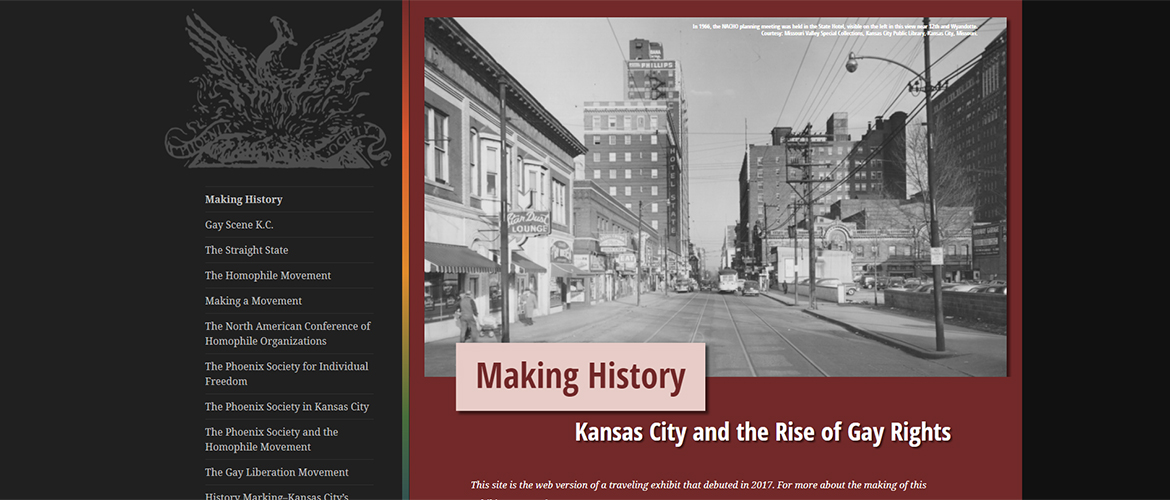A few weeks ago, an exhibit that I co-curated and designed while an MA student at the University of Missouri-Kansas City was removed from the Missouri State Capitol. I had only found out the day before that the pop-up traveling exhibit Making History—made of twelve stand-alone panels—was in the Capitol building, in the Missouri State Museum, and was scheduled to remain there through the end of December. I was delighted to learn that the exhibit, which debuted in 2017, was still traveling, and that it had been given a place in my home state’s capital.
The exhibit is about Kansas City’s surprisingly central role in the history of the early gay rights movement in the United States. We created it in part to draw attention to the installation of a historical marker commemorating the first national meeting of homophile organizations (the name used for early gay rights groups) in the country.
The day after I learned the exhibit was in the Capitol, though, I received a text from one of my former professors: “Hey, I wanted to give you a heads-up. I found out this morning that the Making History Exhibit was removed from the Missouri State Museum.” The text linked to a news story from the St. Louis Post-Dispatch. (I won’t bother explaining again how a few exaggerated complaints resulted in the exhibit’s relocation; the Kansas City Star and Missouri Independent have also both done a good job of following the case and reporting on its broader implications.)
As I have said to many people since this all began, there is a silver lining. In the days after the exhibit was removed, its digital version had thousands of site visits, thanks to the many articles, facebook posts, and tweets that linked to it. I have received a handful of kind comments through the site’s contact form. To my pleasant surprise, I have received no hate mail (although Sen. Greg Razer, who was first alerted to the exhibit’s removal and has championed it ever since, has not been so fortunate). There have been multiple invitations to host the exhibit elsewhere.
This is all gratifying. Far more people have seen the exhibit online thanks to the controversy than ever would have seen it on display in the Capitol. It’s nice to know that more Missourians have had the chance to learn about this part of Missouri’s history.
But I have found that the more I repeat this line about the upside of online visits, the more hollow it feels. The trouble with silver linings is that they too easily redirect our attention from the lingering storm cloud.
Five thousand site visits doesn’t erase the message that some Missouri legislators have sent that LGBTQ history—and, it feels implied, LGBTQ Missourians themselves—have no place in the state capitol. It doesn’t take away the pain of state staffers whose tweets I saw, remarking that these same legislators smiled and waved at them in the halls without knowing that the staffers were out and hurt by these actions. I fear for the LGBTQ youth whose state representatives led this charge, who might be struggling to feel like they belong in Missouri at all. I am angry for the UMKC students (including me) who had had to watch weeks of silence from UMKC leaders who have failed to voice their support for this exhibit—an exhibit, I’ll note that they had no trouble celebrating with a press release when it won a national award. I am even more angry for the current LGBTQ UMKC students who have had to watch that same silence and wonder if the university would come to their defense. And I am sad that so many of the things we wrote about in the exhibit as history—fear of reprisal for being publicly out, fearmongering about imagined threats to children, discrimination against LGBTQ citizens by government—are all playing out in front of me in my own state.
A friend, in response to all of this, noted that it was another moment that made it hard to love Missouri. This makes me sad, too. I am a Missourian by choice; I graduated from Mizzou (after growing up in the West) and returned five years later with my husband, a Missourian by birth, to make this state my adopted home. There are a lot of things that are hard to love about Missouri right now. It is tempting to grow disgusted, to want to leave, to throw up my hands, say “to hell with it,” and leave the state to those who seem to feel like it only belongs to others who look and believe exactly the way they do. But I don’t want to do that. I want to stay and make Missouri home. I want to love this state.
The trouble with silver linings is that they are too comforting. Too many times people have nodded with satisfaction after I tell them about the online exhibit numbers. But this lets us all off the hook far too easily. The problem isn’t how many people have or have not seen the exhibit. It’s about the fact that a small, angry, cruel minority could so easily silence so many others in the state. If we focus too much on that silver lining—or we give up and move away—their voices become louder, their belief that only they belong here becomes only more snug and assured.
I love Missouri. I am determined to keep staring hard into its storm clouds.
P.S. I will echo Sen. Razer in his encouragement to go see the exhibit in its far less prominent new location in Jefferson City, if you’re in the area.
